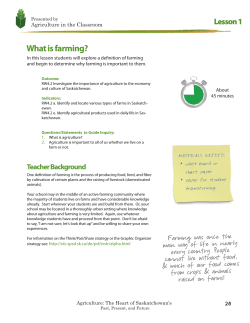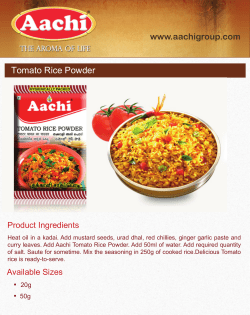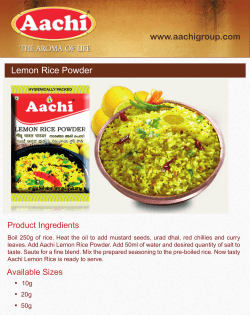
How to Cultivate Indigenous Microorganisms
Biotechnology Aug. 2008 BIO-9 How to Cultivate Indigenous Microorganisms Hoon Park1 and Michael W. DuPonte2 Ocean Star Hawaii Natural Farms, LLC 2 CTAHR Department of Human Nutrition, Food and Animal Sciences, Komohana Extension Office 1 P ast trends in conventional western agriculture, including monoculture without crop rotation, overuse of inorganic fertilizers, and wide-scale applications of broad-spectrum organophosphate pesticides, have hindered the role of naturally occurring microorganisms in promoting biological nitrogen fixation and decomposition of organic matter, microbiologically enhanced plant nutrient uptake, and other natural soil processes that depend on active soil microbe populations. The current trend in U.S. agriculture, including Hawai‘i agriculture, is toward less chemically intensive, more biologically based practices, in the hope that they may improve soil health and agricultural production and be less harmful to the environment than conventional agricultural production methods. In Asian countries, including Korea, deliberate collection and culturing of naturally occurring soil microorganisms has been a common agricultural practice for centuries, and application of these cultures to crop soils is believed to minimize the need for applications of inorganic soil amendments. However, little scientific documentation of the benefits of these practices exists. This publication outlines the principal steps in culturing naturally occurring microorganisms in a process similar to one used on farms in Korea. Those wishing to culture and utilize microorganisms in this way should be aware that the value of the techniques and applications described has not been verified in Hawai‘i by controlled experiments. Therefore, the practices described in this publication should be considered as suggested, rather than recommended. Collecting microorganisms from the environment When is the best time to collect microorganisms? Microorganisms (microbes) may be cultured at any time of the year; however, avoid wet, rainy seasons. Excessive moisture in the environment promotes growth of fungi that are less desirable for the intended uses. How time-consuming is it to collect these microbes? The collection process takes approximately 4–5 days in cooler weather (about 68°F, 20°C) and 3–4 days under warmer conditions (> 68°F, 20°C). Where are the best places to collect microorganisms? Beneficial microbes are highly concentrated under undisturbed forests or other vegetated areas. Combining microbes collected from multiple sites will likely result in a more robust culture. What collection supplies will I need? Collection materials are relatively inexpensive and readily obtainable. • a small wooden box, 12 x 12 x 4 inches deep, preferably made of cedar (photo 1) • steamed white rice • white paper towels, enough to cover the wooden box • two to four large rubber bands • a sheet of clear plastic, large enough to completely cover the wooden box • 1 ⁄4-inch mesh wire screen large enough to completely cover the wooden box. Published by the College of Tropical Agriculture and Human Resources (CTAHR) and issued in furtherance of Cooperative Extension work, Acts of May 8 and June 30, 1914, in cooperation with the U.S. Department of Agriculture. Andrew G. Hashimoto, Director/Dean, Cooperative Extension Service/CTAHR, University of Hawai‘i at Mänoa, Honolulu, Hawai‘i 96822. An equal opportunity/affirmative action institution providing programs and services to the people of Hawai‘i without regard to race, sex, age, religion, color, national origin, ancestry, disability, marital status, arrest and court record, sexual orientation, or status as a covered veteran. CTAHR publications can be found on the Web site <http://www.ctahr.hawaii.edu/freepubs>. UH–CTAHR How to Cultivate Indigenous Microorganisms How are collection supplies assembled? Fill the wooden box with 3 inches of steamed rice (photo 2). Cover the box with white paper towel, being careful not to let the towel touch the rice (photo 3). There should be an inch or so of air space between the rice the paper towel. Use rubber bands around the top of the box to secure the paper towel in place. Cover the top of the box with wire screen (photo 4) to prevent animals from tampering with the rice. Top the wire with a sheet of clear plastic to protect the box from rain, and place it under trees or in another secluded area. The box should not be in direct sunlight. Partially bury the box in the soil (photo 5). It should be buried at least 2 inches deep for best results. Cover the box with fallen leaves from the harvest location (photo 6). Anchor the plastic sheet on all sides with small rocks to prevent it from being dislodged by wind. Leave the box undisturbed for a minimum of 4–5 days. After that time, check to see whether the moist rice is covered with white mold. If mold growth is sparse, re-cover the box and wait an additional 2–3 days before re-checking. If the mold is a color other than white (other colors indicate growth of less effective fungi) or if rain has entered the box, the contents should be discarded and the process repeated. Culturing the microorganisms Once the desired microbes have been collected, the next step is to increase their numbers. What materials are necessary for culturing? The basic supplies for microbe culturing are • a clean clay pot (hard-fired, glazed, or terra cotta) • a wooden spoon • white paper towels • rubber bands • a large clear bowl, big enough to hold contents of rice mixture • a small food scale • a straw mat • a shovel • a composting thermometer • raw, granulated brown sugar • wheat mill run* or, if available, mushroom growth medium waste. *Wheat mill run (WMR), also called “wheat midds” or “middlings,” is the materials remaining after flour, or BIO-9 — Aug. 2008 semolina, is extracted from wheat or durum during milling. WMR generally includes ground screenings from cleaning; remnant particles of bran, germ, and flour; and other offal from the milling process. In Hawai‘i, the basic source of WMR is Hawaiian Flour Mill in Honolulu (808 527-3215), a subsidiary of Pendleton Flour Mills; they sell it by the truckload or containerload, and in pallets of various sizes of packaged containers (60-pound bags, and larger) to the livestock industry (for feed), garden supply stores (for bokashi compost), and mushroom farms (for growing medium). How are the materials assembled to cultivate microbes? 1)Weigh and record the weight of the large bowl. 2)Use the wooden spoon to move the molded rice from the wooden box into the bowl (photos 7, 8). Weigh the filled bowl and calculate the weight of the rice mass by subtracting the weight of the empty bowl from the filled bowl. 3)Gradually add an amount of granulated brown sugar equal to the weight of the rice mass (photo 9). Handknead the sugar and rice until the material has the consistency of gooey molasses (photo 10). Protective gloves are suggested. 4)Fill the clean clay pot two-thirds full with the rice/ sugar mixture (photos 11, 12). Cover it with paper towel secured in place with rubber bands (photo 13). 5)Store the pot in a cool area away from direct sunlight for 7 days. This will allow the mixture to ferment. 6)Working in a shaded area (photo 14), add a small amount of water to the fermented rice mixture in a 1:500 ratio. Then, slowly blend in wheat mill run (or used mushroom medium) until mixture is of semi-moist but not wet consistency (roughly 65–70% moisture) (photos 15–17). 7)Place a mound of the mixture on a soil surface and cover it with the straw mat or leaves, protecting it from sunlight (photo 18). Allow the microbes to propagate for 7 days. Periodically examine the external surface of the pile for white mold growth, monitor internal temperature of the pile with a composting thermometer so as not to exceed 122°F (50°C), and turn the pile with a shovel (a minimum of three to four times during the week) to keep fermentation temperatures from getting too high. 8)When the fermentation process is finished, internal temperature will stabilize, indicating cultivation is UH–CTAHR How to Cultivate Indigenous Microorganisms 1 2 3 4 5 6 BIO-9 — Aug. 2008 UH–CTAHR How to Cultivate Indigenous Microorganisms 7 8 9 10 11 12 BIO-9 — Aug. 2008 UH–CTAHR How to Cultivate Indigenous Microorganisms 13 14 15 16 17 18 BIO-9 — Aug. 2008 UH–CTAHR How to Cultivate Indigenous Microorganisms 19 finished. Your culture of naturally occurring microorganisms is now ready for use (photos 19, 20). Application What do I do with the fermented mixture? Dilute the final product (1 to 1 by volume) with soil and incorporate this mixture into the surface soil as a topdressing for crop production, or add it to your compost pile. This biological soil amendment is expected to enhance soil microorganism activity. For more information, please contact the author (mduponte@hawaii.edu). Acknowledgments The project team thanks the Farm Pilot Project Coordination, Inc (FPPC) and the CTAHR Integrated Pest Management (IPM) Project for providing funding for the production of this publication. The team also thanks Ruth Niino-DuPonte, Glenn Sako, Luisa Castro, and Piper Selden for their constructive comments and suggestions. BIO-9 — Aug. 2008 20 References Kyu, Cho Han. Natural farming. 2003. Janong Natural Farming Institute, Chungbuk, Republic of Korea. Szmanski, N., and R.A. Patterson. 2003. Effective microorganisms (EM) and waste management systems in future directions for on-site systems: Best management practice. Proceedings of the On-site ’03 Conference, University of New England, Lanfax Laboratories Armidale. ISBN 0-9579438-1-4 p. 347–354. Mazzola, M. 2004. Influence of plant genotype on development of interactions with non-symbiotic plant beneficial soil microorganisms. Research Signpost: Research Developments in Agricultural and Food Chemistry. 37:103–122. Kirk, J.L., L.A. Beaudette, M. Hart, P. Moutoglis, J.N. Klironomos, H. Lee, and J.T. Trevors. 2004. Methods of studying soil microbial diversity. Journal of Microbiological Methods 58:169–188. Natural Farming Primer Written by Jackie Prell Wednesday, 24 March 2010 14:11 Master Cho mixes it up with research results, philosophy, and humor at the Feb. 26 - March 4, 2010 workshop in Hilo. What if the best fertilizer was under your feet? What if you could make a product similar to EM and Bokashi simply and cheaply? Well, you can. It’s been happening in South Korea for decades and we have been fortunate to learn the basics here in Hawaii. Four years ago we bought a farm on the Big Island with soil that was flooded for more than seventy years with herbicides, fungicides, and arsenic: the usual arsenal of chemicals used by ginger, sweet potato and sugarcane growers. We were excited to be on land with soil, not just lava rock, common on the Big Island, but were immediately dismayed to see and feel the soil close-up: dry, lifeless powder, not a worm to be found. Our first crops struggled against weeds and pests. Then, a year and a half ago we were introduced to Natural Farming with Indigenous Microorganisms (IMO’s) and we are seeing amazing improvements in our soil structure and plant health. Wherever we put down our homemade, mycorrhizae-rich, “fertility drug” as my husband calls it, the soil regains its loaminess, tilth and structure, and the earthworms come in droves. The basic theories of Natural Farming include: 1. 2. 3. 4. 5. 6. 7. Use the historic nutrients of seeds Use the indigenous microorganisms (IMO’s) Maximize the inborn potential Do not use chemical fertilizers Do not till the land Zero emission of livestock wastewater Sow less, yield more Natural Farming with IMO’s is a distinctive approach to organic farming that is practiced successfully in over 30 countries, in home gardens and on a commercial scale. Mr. Han Kyu Cho first formulated and fine-tuned these practices for 40 years and has trained over 18,000 1/6 Natural Farming Primer Written by Jackie Prell Wednesday, 24 March 2010 14:11 people at the Janong Natural Farming Institute ( http://janonglove.com ). Then Dr. Hoon Park brought Natural Farming to Hawaii. Dr. Park was in South Korea doing missionary work and noticed commercial piggeries with virtually no smell that were using Natural Farming methods. He learned about Natural Farming and realized that this was a practice that could eliminate hunger and poverty in extremely poor parts of the world. He came back to Hawaii, his home, and began giving classes for free. Demonstrations throughout the workshop clearly showed the steps for making potent natural fertilizers. Natural Farming is unique in that it is not meant to be commercialized, but rather practiced by farmers, with cheap, easily available ingredients, and microbes or mycorrhizae indigenous to each locale or farm. These microorganisms are 1) cultured in a simple wooden box of rice, 2) mixed with brown sugar and stored in a crock, 3) further propagated on rice bran or wheat mill run, 4) mixed with soil and cultured again. This is then mixed with 5) compost, or added to potting soil or spread on beds before planting. The entire process takes 3 to 4 weeks. A complete guide to making this input can be found by following a link on our club’s website, http: //localgarden.us . Other inputs and sprays are made from fermented plant juices, made from the tips of growing plants mixed with brown sugar. There are also recipes for water soluble calcium made from eggshells, fish amino acid made from fish waste, lactic acid bacteria , and 2/6 Natural Farming Primer Written by Jackie Prell Wednesday, 24 March 2010 14:11 insect attractants made from rice wine. There is also water-soluble calcium phosphate made from animal bones and vinegar and a seed soak solution. There are a half dozen more inputs that can be made simply and easily at home, which are used according to the nutritive/growth cycle of the plants. Many of these inputs are made from things that would otherwise just be thrown away. We get fish waste from the local fish market, which the market would have to pay to dispose of otherwise. The fish amino acids is simply fresh fish waste, de-boned and packed into a container with brown sugar and fermented for a few months. Some of the IMO ingredients. The benefits of using the Natural Farming methods include: 1. Lower cost to the farmer (by as much as 60%) 2. More desirable crops 3. Stronger, healthier and more nutritious plants 4. The inputs are made from natural materials, which are not only safe for the environment, but actually invigorate and rehabilitate the ecology. 5. Higher yield 6. Better quality 7. Farmer friendly 8. Zero waste emission Several University of Hawaii at Hilo Community College professors have been learning Natural Farming and practicing it, as well as going to South Korea to observe it firsthand. David Ikeda, a professor at HCC teaches basic Natural Farming classes and another professor, Michael DuPonte, has helped to establish a piggery in Mountain View using Natural Farming methods and feed. The pigs excrement is so odorless, clean and dry, that you literally don’t even have to 3/6 Natural Farming Primer Written by Jackie Prell Wednesday, 24 March 2010 14:11 clean it out. Methods for raising chickens are similar, with healthier chickens, less work and no smell. Their bedding can remain in place for 10-20 years or just be pulled out when it’s needed for fertilizer. Natural Farming has been embraced by the South Korean government after one county experimented, with every farmer in the county practicing it for a year. These rice farmers not only had bigger yields than usual, but saved money on their inputs and sold their rice for a premium. Where they practiced Natural Farming they had the added benefit of cleaning up the waterways, rivers and even coastal waters. Also in South Korea a co-op of 40 strawberry farmers uses Natural Farming methods exclusively in their 300' long greenhouses producing gorgeous, scrumptious strawberries, which again sell for a premium. And in another wide scale experiment, an entire county is practicing a model of totally self-sufficient farming where each farm has 500 chickens, 20 pigs and five beef cattle. Dr. Hoon Park, who brought Natural Farming to Hawaii, interprets for Master Cho at the 2010 Hilo workshop. Mr. Cho has spread Natural Farming worldwide. He went to the Gobi Desert in Mongolia and planted trees there. Efforts to plant trees had failed three times earlier, under the harsh wind and with only a few inches of rainfall a year. With Natural Farming methods the trees had a 97% survival rate and are now 20' tall. Corn and barnyard grasses have been planted for livestock feed and wells have been dug. Watermelon farming now provides a stable income to farmers there also. When the Chinese were preparing for the Olympics to be held in Beking, China, the Chinese army came in, bringing with them their pigs, which they raise to feed themselves. The 4/6 Natural Farming Primer Written by Jackie Prell Wednesday, 24 March 2010 14:11 population of Beking was suddenly assaulted by the smell of pig waste and protested violently. The head of the Chinese army sent two men to South Korea to study Natural Farming, which he had heard about. The men came back and the army immediately started practicing the Natural Farming methods and the smell went away. The University of Peking now offers Masters and Ph.D programs in Natural Farming. Mr. Cho’s son has created his own methodology of Natural Farming which is even cheaper. His basic recipe for introducing indigenous mycorrhizae to the soil and increasing micro-biological activity on one-quarter acre of land follows. Into 125 gallon container of water, put 5 gallons of ocean water, 6-7 lbs. of sugar, 2 liters of agricultural mineral water (water which has had an aquarium pump circulating the water or has been dropped from 10 feet onto mineral stone or azomite). Now go to a naturally fertile, shaded spot on your land and scoop up a handful of soil off the top half an inch: soil that has it’s own mycorrhizae already present and thriving. Add to this, a handful of soil from three different naturally fertile spots. Mix these soils together and take one handful and drop it into a pint of water. Add to the 125 gallons of water. The last ingredient you make in a blender with wild grasses. Pack a blender with wild grass and a little water and blend. Make 2 quarts of this and add it to the 125 gallons of water/mix. Let this mixture sit for 18 to 20 hours. To apply it directly onto the soil, dilute it 10 times. To foliar feed, dilute it 20 times. Apply it during rain or right before rain or in the evening or early morning. This solution can be applied 8 to 10 times a year for the best results. Very simply, Natural Farming is the propagation of mycorrhizae, along with protocols for adding specific inputs during the nutritive cycle of the plant. Mycorrhizae are “fungus roots” and act as an interface between plants and soil. They grow into the roots of crops and out into the soil, increasing the root system many thousands of times over. They act symbiotically, converting with enzymes the nutrients of the soil into food the plants can use and taking carbohydrates from the plants and turning it into nutrients the soil can use: “sequestering” carbon in the soil for later use. Miles of fungal filaments can be present in an ounce of healthy soil. Mycorrhizal inoculation of soil increases the accumulation of carbon in the soil by depositing glomalin, which in turn, increases soil structure, by binding organic matter to mineral particles in the soil. It is glomalin that gives soil its tilth, its texture and rich feel, its buoyancy and ability to hold water. Can Natural Farming be done with no store-bought fertilizers? It is being done not only in home gardens but also on a commercial scale. For us, here in Hawai‘i, it is incredibly empowering to mix our own mycorrhizae-rich soil amendments and to be weaned from the fertilizer store. It is simple, cheap and easy to try. Follow the steps at the http://localgarden.us website and make your own. Plant a tray of seedlings with it, and next to it a tray of seedlings without it. You’ll be impressed by the difference. 5/6 Natural Farming Primer Written by Jackie Prell Wednesday, 24 March 2010 14:11 6/6
© Copyright 2025












